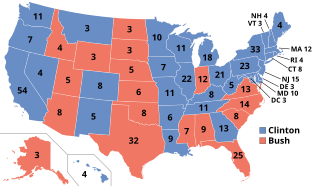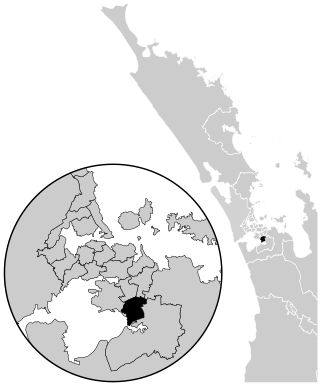Related Research Articles

The 1992 United States presidential election was the 52nd quadrennial presidential election, held on Tuesday, November 3, 1992. Democratic Governor Bill Clinton of Arkansas defeated incumbent Republican President George H. W. Bush and independent businessman Ross Perot of Texas. The election marked the end of a period of Republican dominance in American presidential politics that began in 1968, and also marked the end of 12 years of Republican rule of the White House, as well as the end of the Greatest Generation's 32-year American rule and the beginning of the baby boomers' 28-year dominance until 2020. It was the last time the incumbent president failed to win a second term until Donald Trump in 2020.

The 1988 United States presidential election was the 51st quadrennial presidential election held on Tuesday, November 8, 1988. Incumbent Republican Vice President George H. W. Bush defeated the Democratic Massachusetts Governor Michael Dukakis.
An electoral college is a set of electors who are selected to elect a candidate to particular offices. Often these represent different organizations, political parties or entities, with each organization, political party or entity represented by a particular number of electors or with votes weighted in a particular way. The United States has been the only democracy in the 21st century that still uses an electoral college to select its executive president. The other democracies that used an electoral college for these elections switched to direct elections in the 19th or 20th century.:215
An electoral alliance is an association of political parties or individuals that exists solely to stand in elections.

Manurewa is a New Zealand parliamentary electorate in southern Auckland. A very safe Labour seat, the seat was created in 1963 and has returned a National MP only once, in 1975. Arena Williams has represented the electorate since the 2020 election.

New Lynn is a New Zealand parliamentary electorate, returning one member to the New Zealand House of Representatives. Deborah Russell of the Labour Party represented the electorate from the 2017 general election before being defeated by National's Paulo Garcia in the 2023 election.

Wairarapa is a New Zealand parliamentary electorate. It was first created in 1858 and existed until 1881. It was recreated in 1887 and has since existed continuously. The current Wairarapa electorate MP is Mike Butterick.

A group representation constituency (GRC) is a type of electoral division or constituency in Singapore in which teams of candidates, instead of individual candidates, compete to be elected into Parliament as the Members of Parliament (MPs) for the constituency. Synonymous to the party block voting (PBV) or the general ticket used in other countries, the Government stated that the GRC scheme was primarily implemented to enshrine minority representation in Parliament: at least one of the MPs in a GRC must be a member of the Malay, Indian or another minority community of Singapore. In addition, it was economical for town councils, which manage public housing estates, to handle larger constituencies.

The 1988 United States presidential election in California took place on November 8, 1988, and was part of the 1988 United States presidential election. Voters chose 47 representatives, or electors to the Electoral College, who voted for president and vice president.

The election of the president and the vice president of the United States is an indirect election in which citizens of the United States who are registered to vote in one of the fifty U.S. states or in Washington, D.C., cast ballots not directly for those offices, but instead for members of the Electoral College. These electors then cast direct votes, known as electoral votes, for president, and for vice president. The candidate who receives an absolute majority of electoral votes is then elected to that office. If no candidate receives an absolute majority of the votes for president, the House of Representatives elects the president; likewise if no one receives an absolute majority of the votes for vice president, then the Senate elects the vice president.

The 1988 United States elections were held on November 8 and elected the President of the United States and members of the 101st United States Congress. Republican Vice President George H. W. Bush defeated Democratic Governor of Massachusetts Michael Dukakis. Despite Dukakis' defeat, the Democratic Party built on their majorities in Congress.
Port Stephens, an electoral district of the Legislative Assembly in the Australian state of New South Wales, was established in 1988.
Myall Lakes, an electoral district of the Legislative Assembly in the Australian state of New South Wales, was established in 1988.
Strathfield, an electoral district of the Legislative Assembly in the Australian state of New South Wales, was first established in 1988, largely replacing Burwood.
Londonderry, an electoral district of the Legislative Assembly in the Australian state of New South Wales, was created in 1988 and has generally been held by the Labor party.

The 1988 United States presidential election in Maryland took place on November 8, 1988, as part of the 1988 United States presidential election. Voters chose 10 representatives, or electors to the Electoral College, who voted for president and vice president.

The 1988 United States presidential election in Vermont took place on November 8, 1988, as part of the 1988 United States presidential election, which was held throughout all 50 states and D.C. Voters chose three representatives, or electors to the Electoral College, who voted for president and vice president.

The 1988 United States presidential election in West Virginia took place on November 8, 1988. All 50 states and the District of Columbia were part of the 1988 United States presidential election. West Virginia voters chose six electors to the Electoral College, which selected the president and vice president.
References
- ↑ Statistics for the General Election Held on Saturday, 1 October 1988. Victoria: Government Printer. 1988.